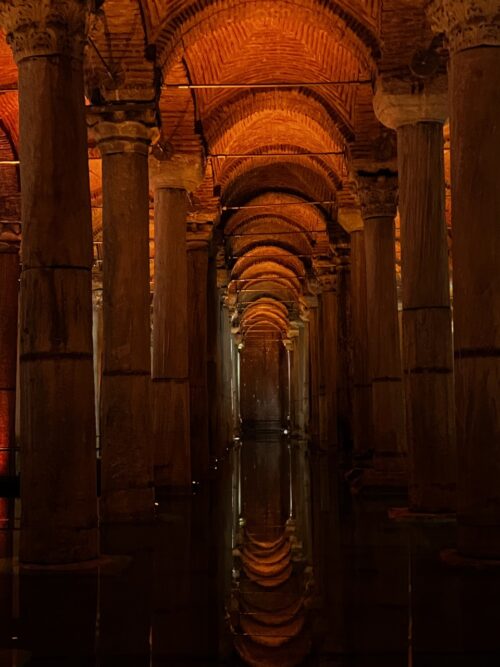
By Jill Lowe
The protagonist Dr.Gillian Perholt, narratologist in A.S. Byatt’s fairy story “The Djinn in the Nightingale’s Eye” purchased a ceșm-i-bülbül in the Istanbul market. Byatt’s book cites çeșm-i-bùlbùl as meaning “nightingale’s eye”. One turkish glass workshop at Incirköy made this Turkish glass, a design of a spiral pattern with opaque blue and white stripes and likened to the nightingales eye, around 1845. Nightingales are popular in Turkey and its poetry has many references to them.

ceșm-i-bülbül
It happened in the fairy story, when Gillian Perholt removed the stopper, a djinn (genie) was released, twice her size and with sea-green eyes flecked with malchite. Beholden to her, his mission, requirement and empowerment was to grant her 3 wishes. So a çeșm-i-büllbül does indeed seem a good thing to acquire!
The movie One Thousand Years of Longing with Tilda Swinton and Idris Alba, is based on Byatt’s fairy story.
Well, although this is fanciful and nonsense, one finds a visit to Byzantium to be filled with folklore, legends and mystical concepts all influencing turkish culture. Just look at this first glimpse of Istanbul.
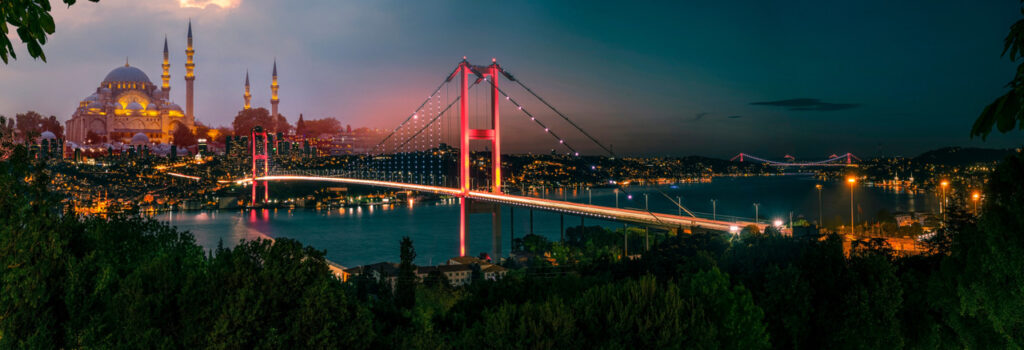
Turkish Airlines prepared us for minarets with our pepper and salt.

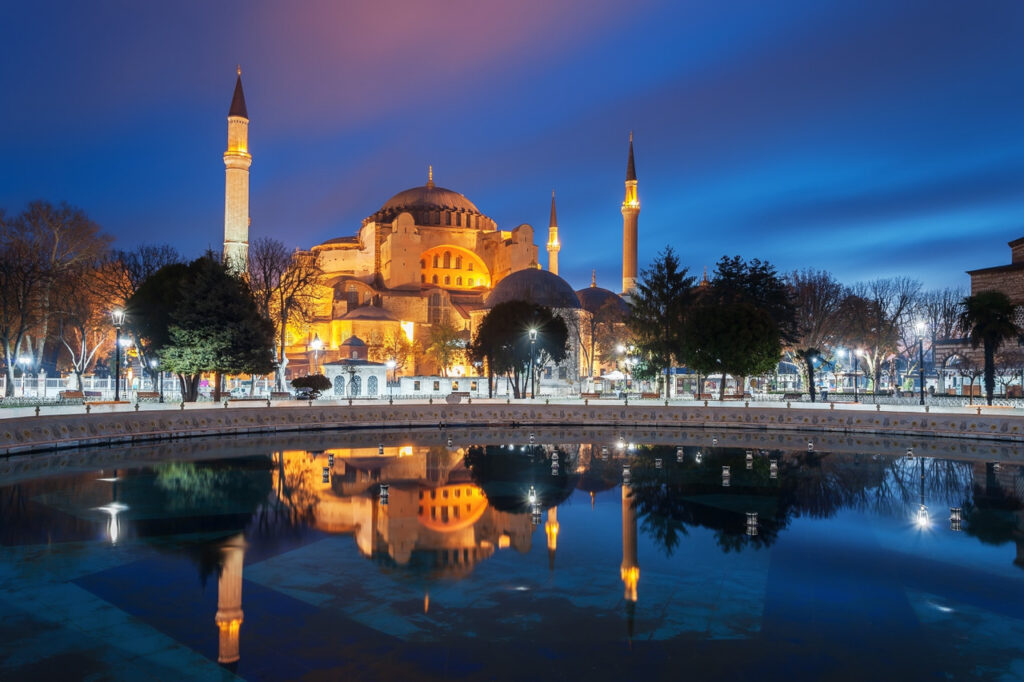
Hagia Sofia
Really nothing can prepare one for Hagia Sofia, built as a Christian Basilica in 6th century under direction of Emperor Justinian, subsequently becoming a mosque, museum and now a mosque again. Anchoring the Old City of Istanbul, the enormous structure has a dome stretching 180ft into the air. Prayer times – 5 times a day and mosque closures all must be considered by visitors.
The minarets, inscriptions of Islam, and lavish magnificent mosaics of Christianity made from gold, silver, glass and colorful stones are intertwined inside and out and in entrances.
 |
 |
 |

Hagia Sofia
In Chicago’s Church of Saint Chrysostom on Dearborn Street is the Crane Chapel. The mosaic of its patron saint Saint John Chrysostom is a copy of one in Hagia Sofia. John Chrysostom was Archbishop of Constantinople and a 4th century theologian.
Chicago’s St Chrysostom’s church historian Dorothy Ramm steered us to find the location of the original in Hagia Sofia, on an upper level balcony. Not easy to detect from the main floor, where visitors must remain, and since converting to a mosque in 2019, many christian mosaics are covered for parts of the day.
 |
 |
Mosaic of St John Chrysostom
The Basilica Cistern Museum
This grand underground cistern, built by Eastern Roman Emperor Justinian I (527-565), is nicknamed “Yerebatan Sarayı” (Sunken Palace) due to its some 336 marble columns rising from the water.
Written sources say the cistern used to distribute water from waterways and rain, meeting the city’s water needs for hundreds of years. It also received water from one of the historical aqueducts called the Hadrianus Aqueduct.
The capitals of the columns exhibit different features. Some reflect the “Corinthian” style, while others stand out with plain, unadorned capitals. Except for a few of the columns with angular or fluted shapes, most of them are observed to be cylindrical.
A guide is very worthwhile because we overheard a visitor behind us saying “If it’s a cistern why did they have such decorative columns?” Well we only knew the answer to be that the columns are all different and decorated because many/most were recycled items not wanted by Greece, as our guide had told us. We all exclaimed that we love the idea recycling in the year 527!
This mysterious, magical place is a museum hosting exhibitions, art performances, special tasteful and impactful lighting. Some Medusa heads recently uncovered provide significant symbols of the Yerebatan Cistern.
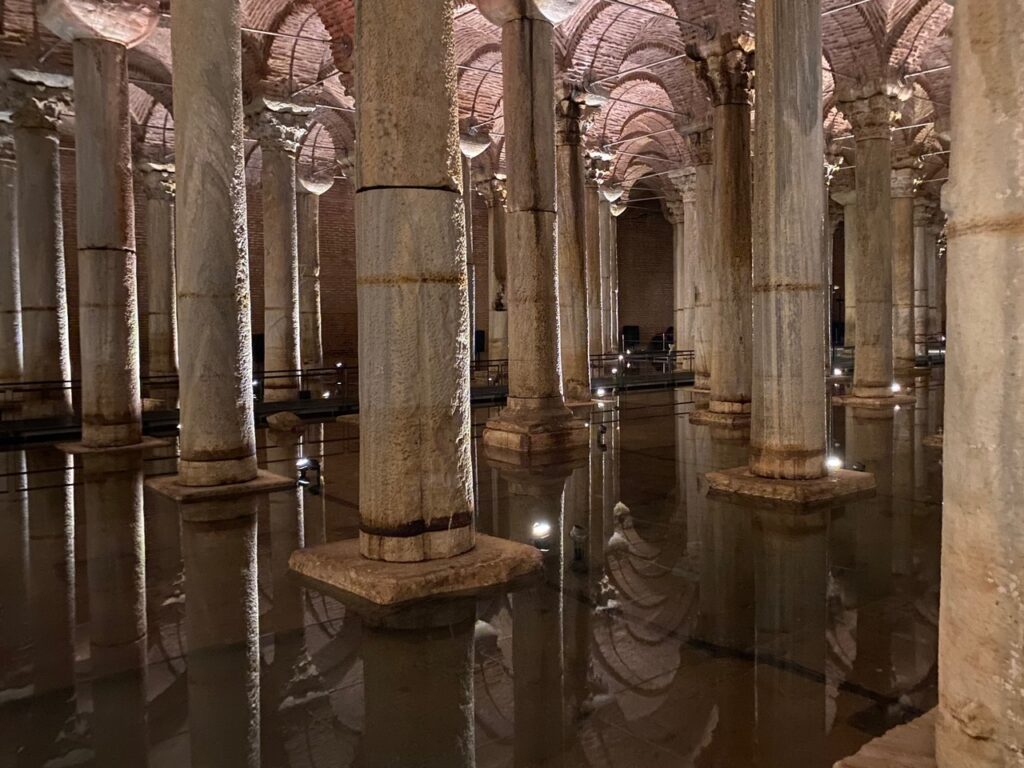
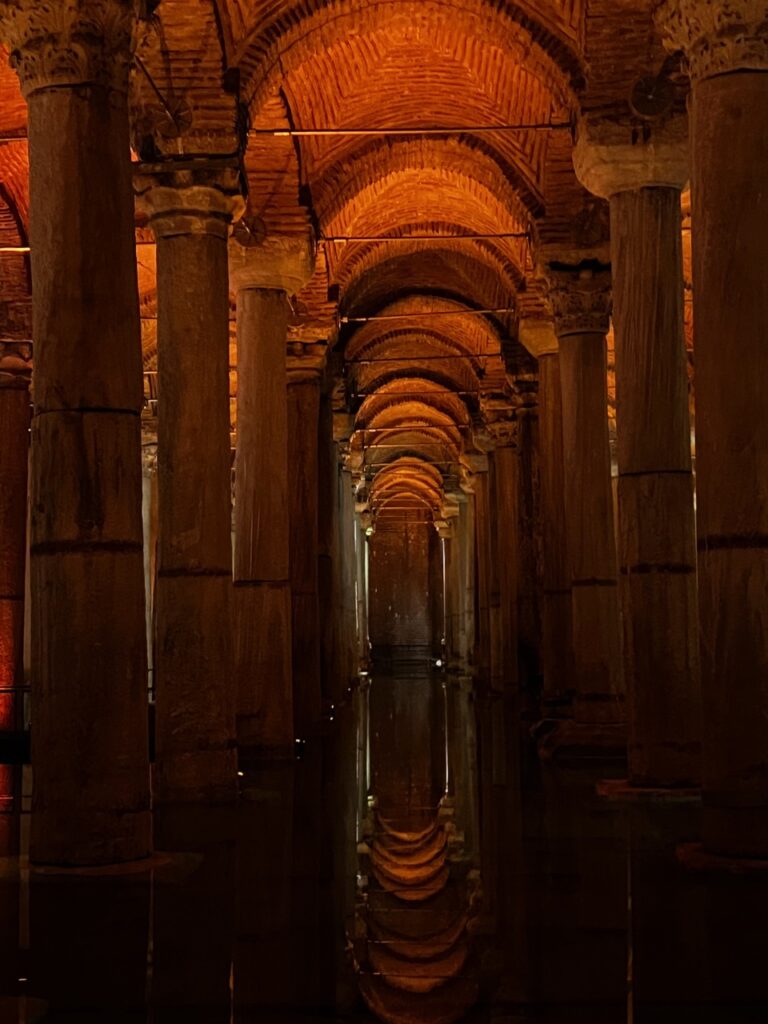


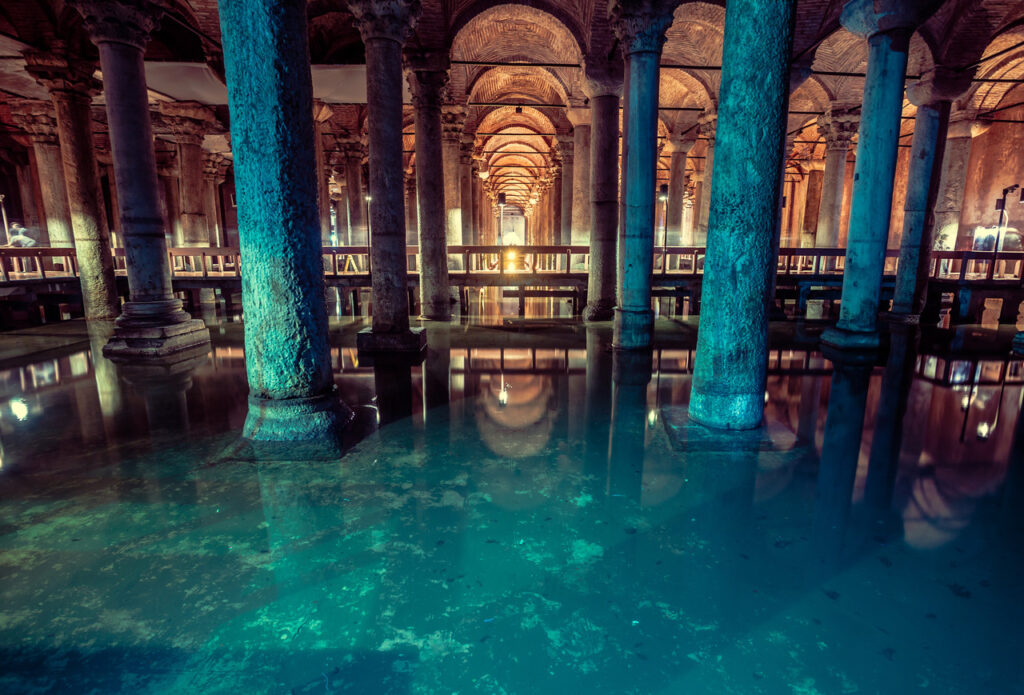

The Blue Mosque (so called by visitors) is the Sultan Ahmed Mosque completed in 1616, and is adjacent to Hagia Sofia, which predates it by 1,100 years. It is called the “blue mosque” because of the 20,000 intricate blue tiles shipped from Nicea about 100 miles away.
 |
 |

A plethora of sights is available to explore in the thriving metropolis of Istanbul. Landmarks of the Blue Mosque, Hagia Sofia, Topkaki Palace, Galata Tower offer glimpses into the city’s rich history, dating back 2,500 years. Once the capital of 3 great empires- Roman, Byzantium and Ottoman – all have left lasting impressions on life and culture.
Here east meets west. The Bosphorus or Bosphorus Strait is a natural strait and an internationally significant waterway that connects the Black Sea to the Sea of Marmara. It forms part of the continental boundary between Asia and Europe, so sunsets, shipping, leisure, water
views are a highlight for all visitors.
With trendy neighborhoods, restaurants, ancient architecture, artists and antiquarian shops, this cosmopolitan city is wonderful to visit. Plenty of books with history, culture can steer one to a particular focus, interest and location .
Whether one spends more time on different sides of the Bosphorus, the city delights.
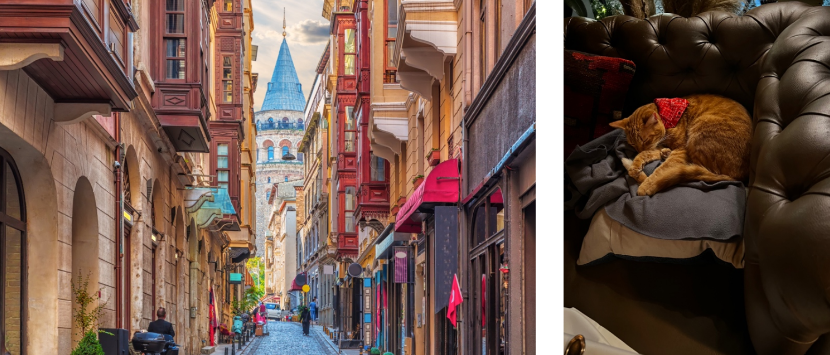
In this area in sight of the Galata Tower is the Georges Hotel Galata whose staff, hospitality and warmth and friendliness was only enhanced by their cat Lollipop!
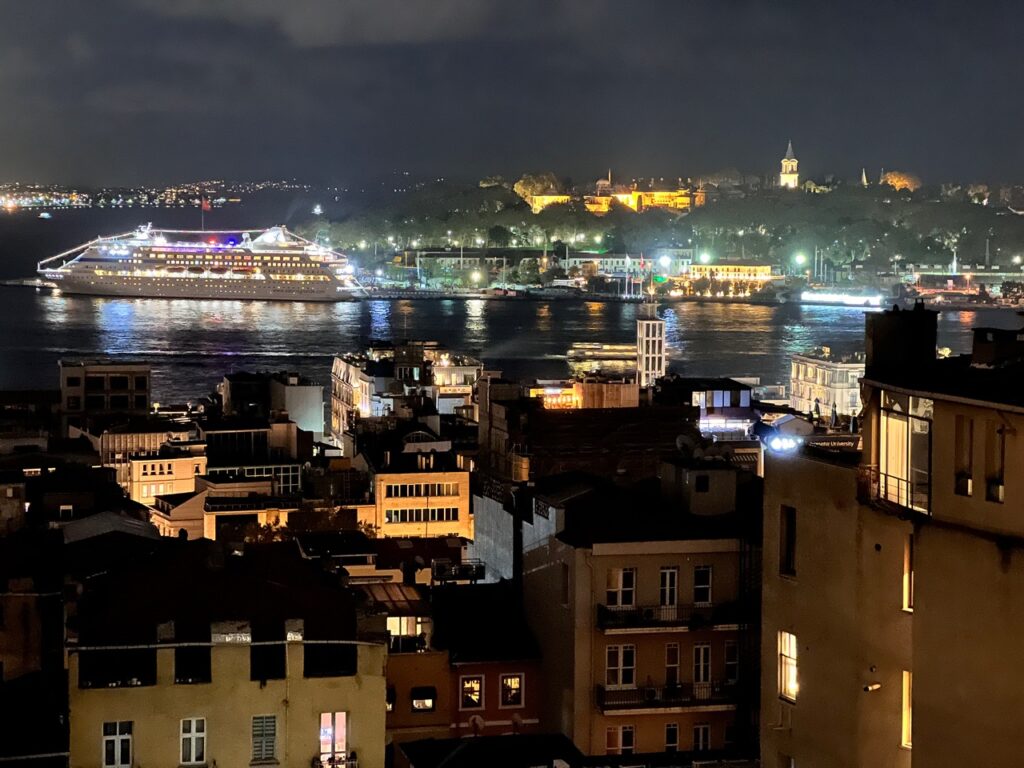
Bosphorus view from the room, and from roof restaurant
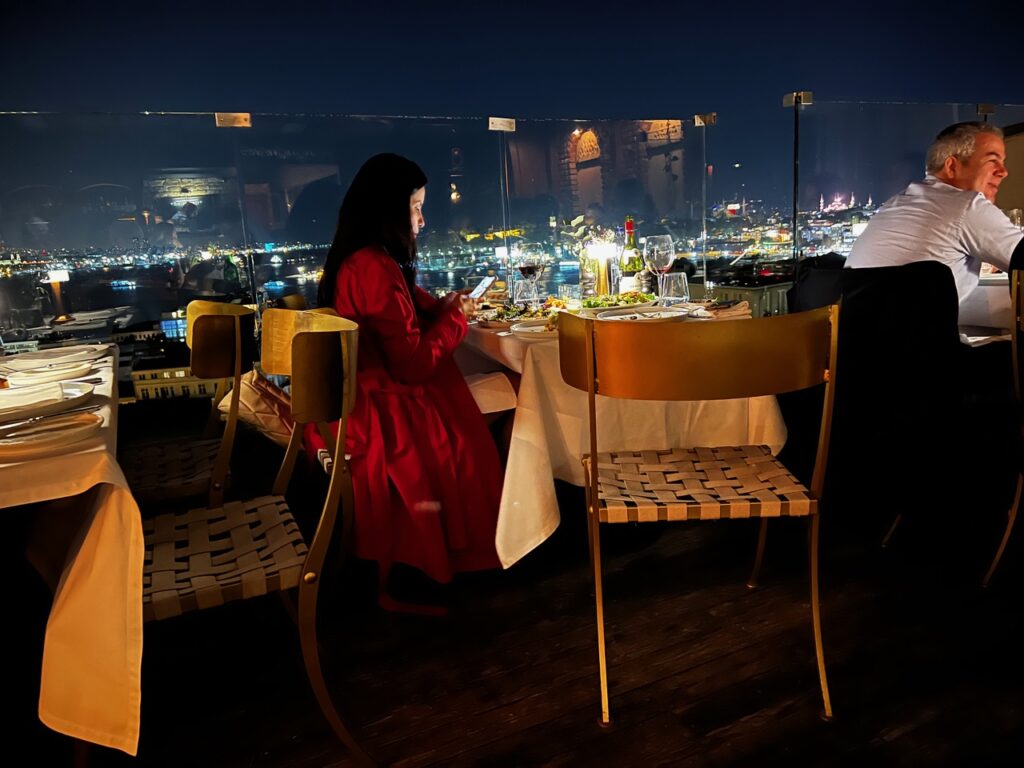
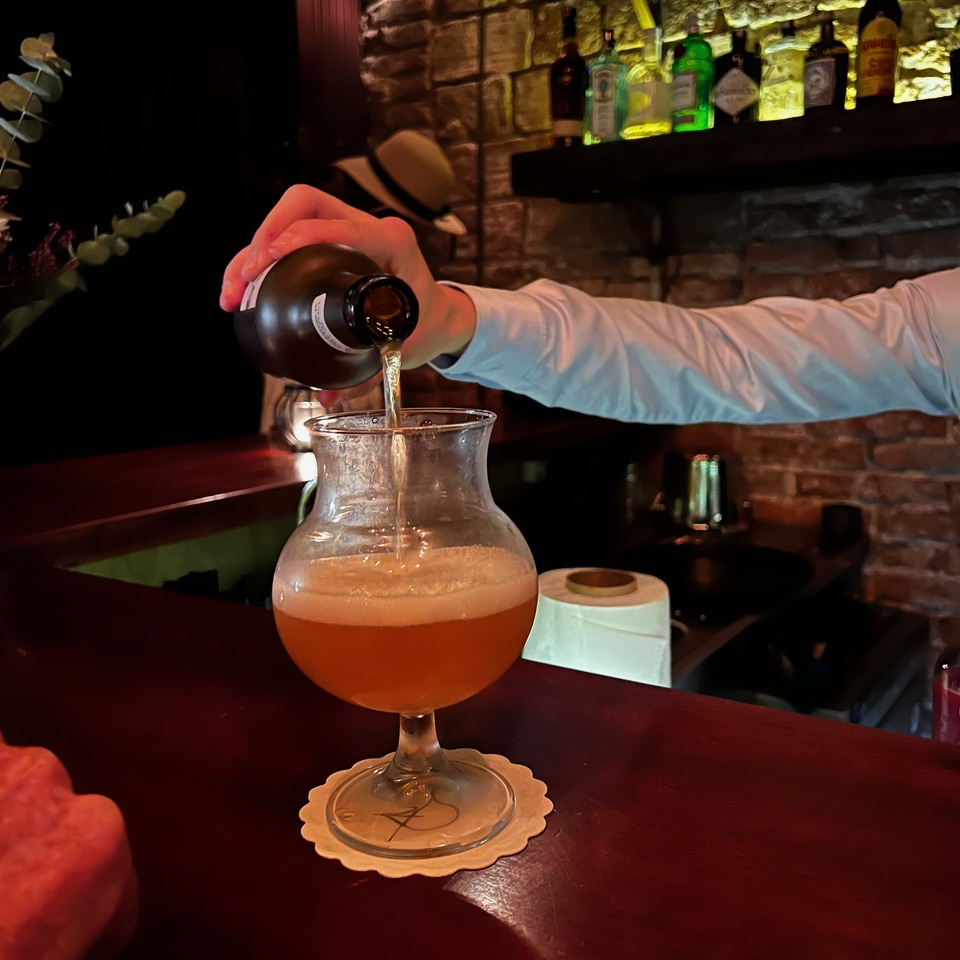 |
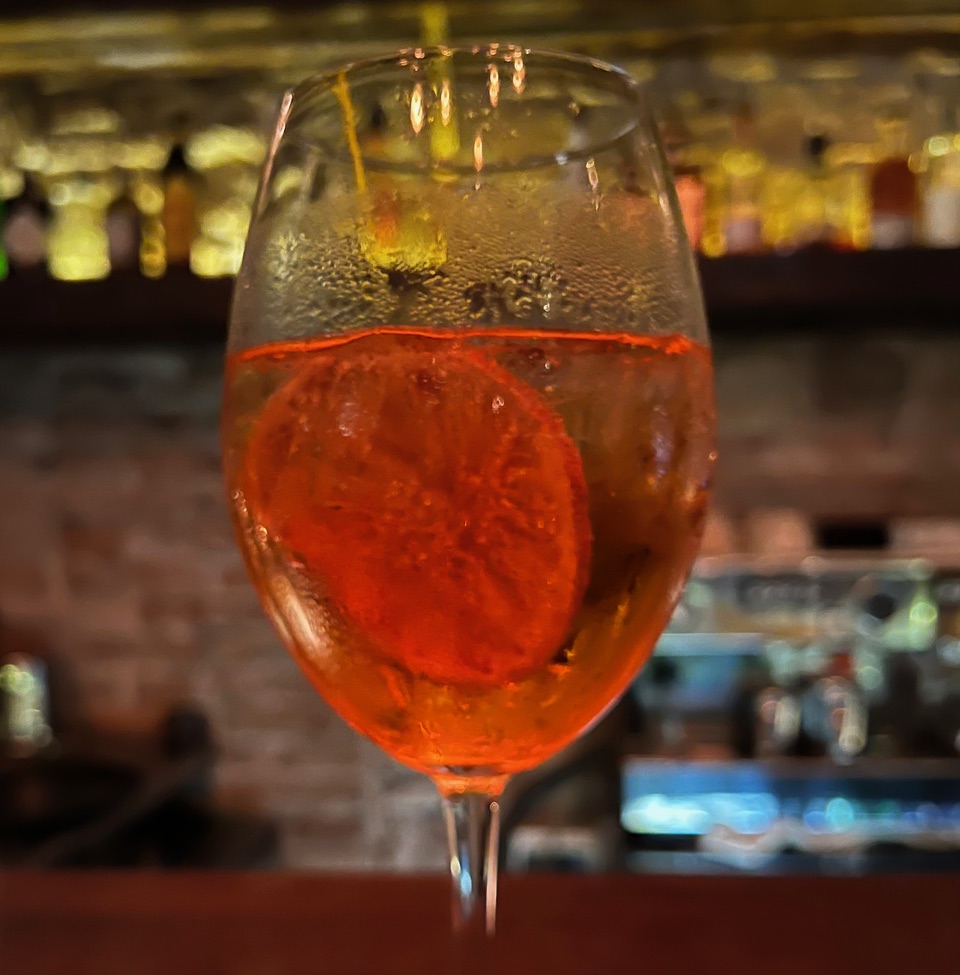 |
A local beer and an Aperol Spritz
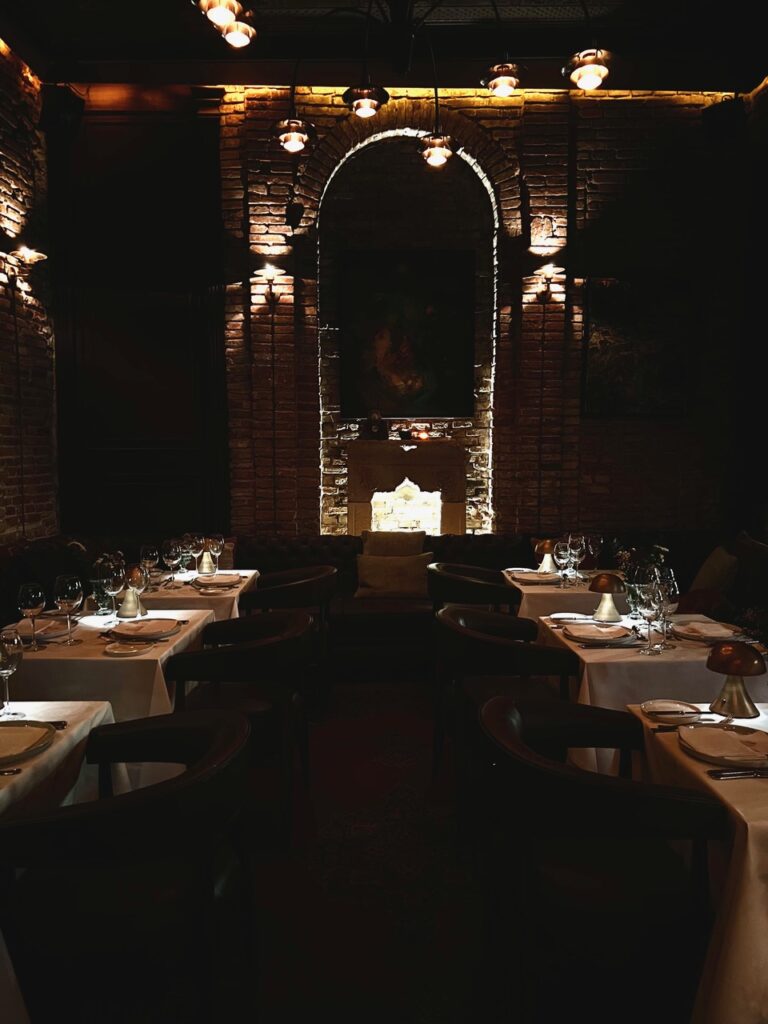
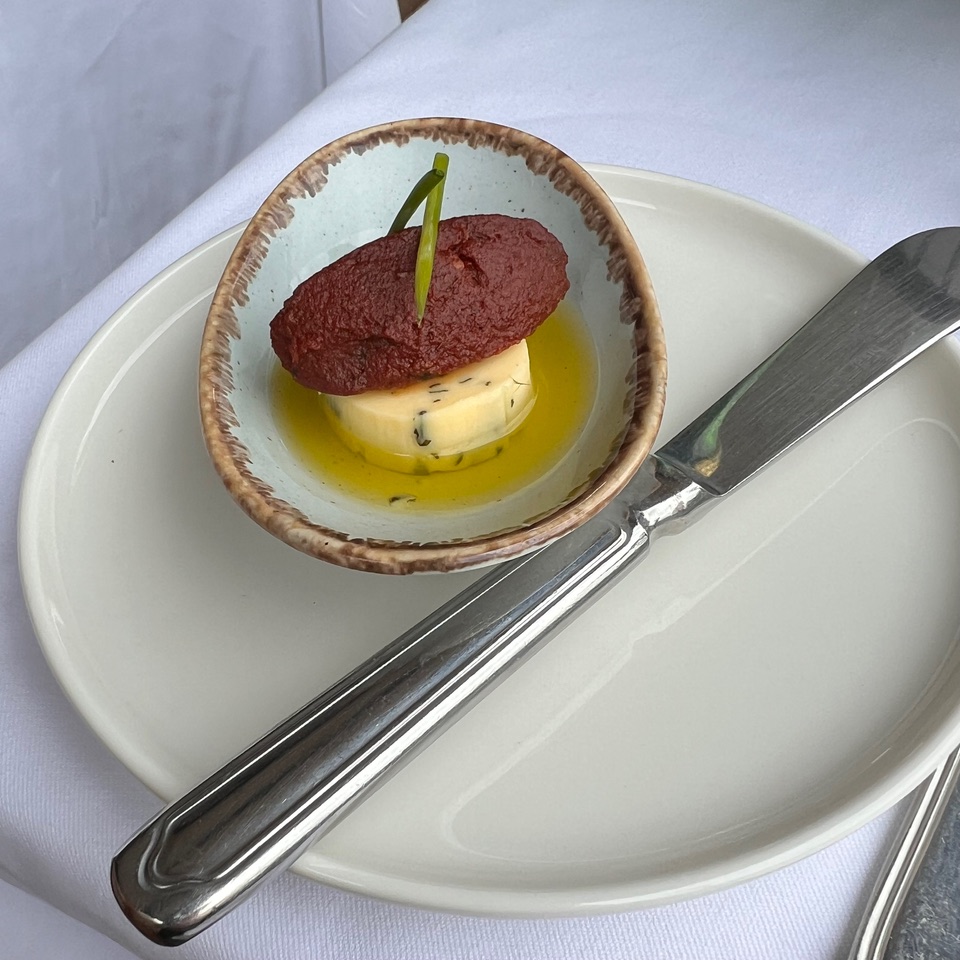
Enhanced butter for delicious bread |
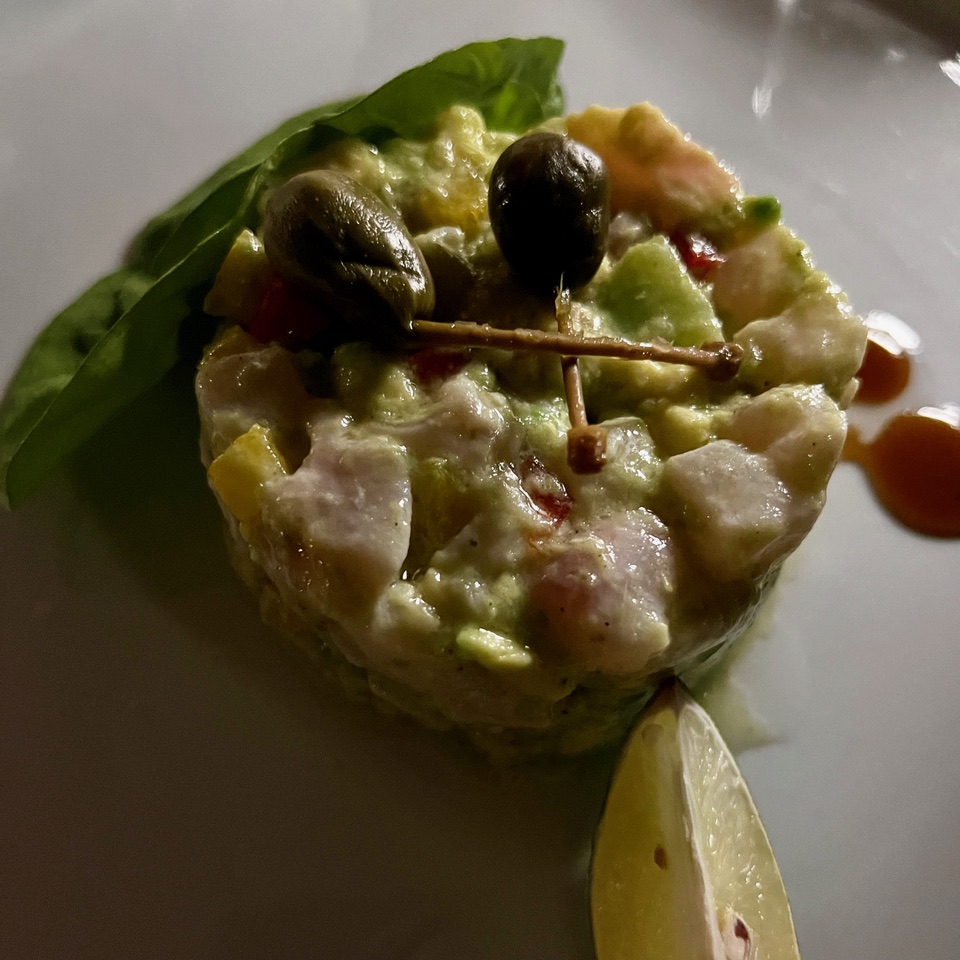
Tartare of sea bass and vegetables |

Smoked tomato, watermelon, coriander, sumac, sour cherry sorbet. Oh my!
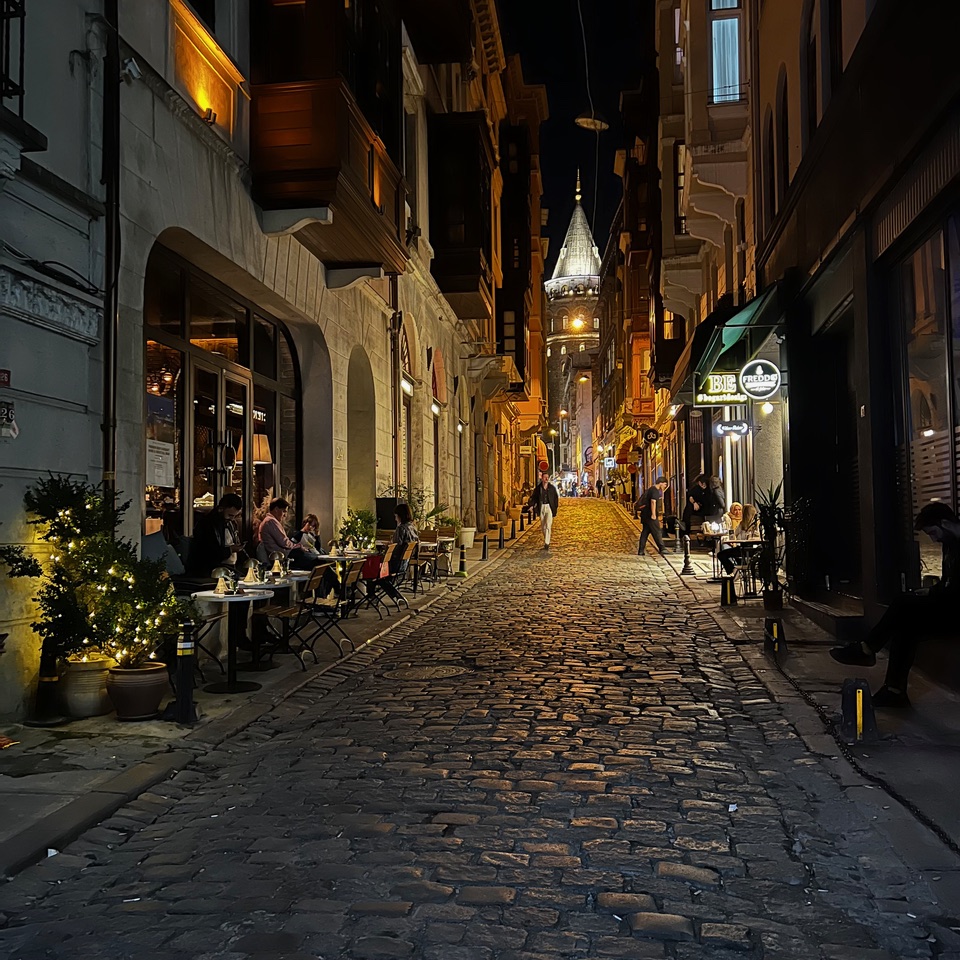
Coffee after dinner?
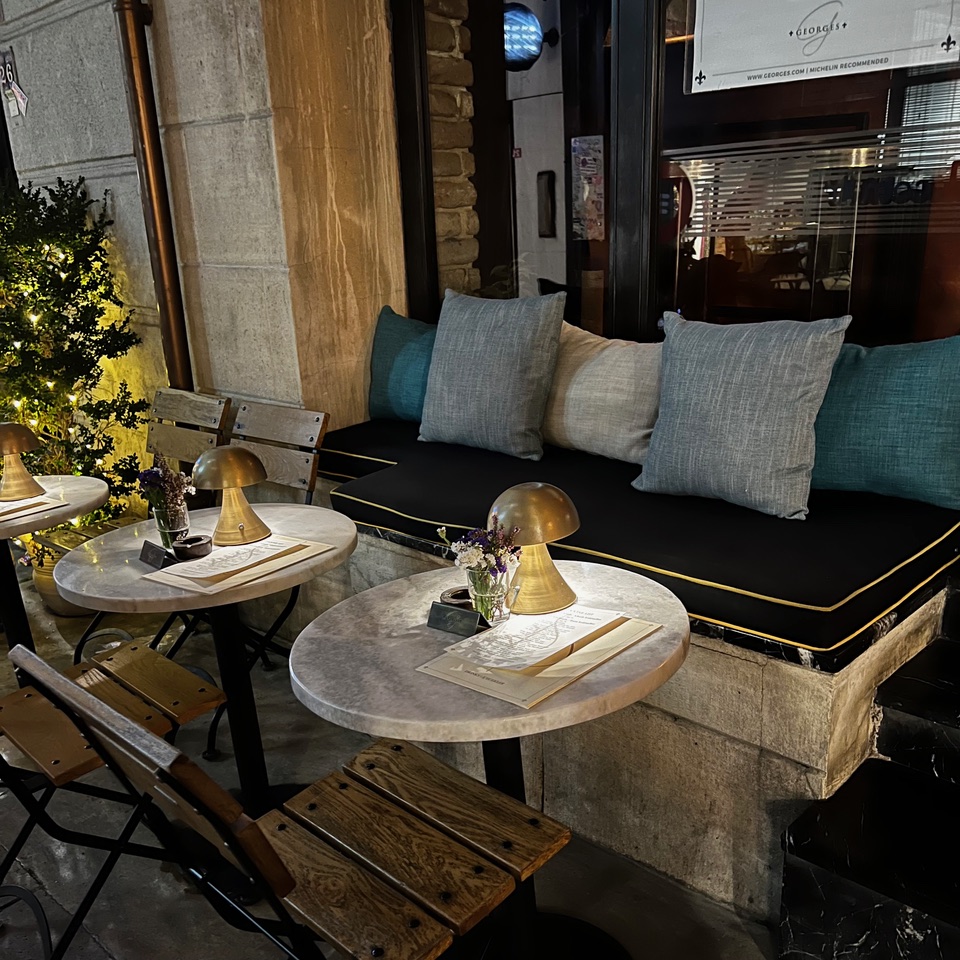
The markets are enticing, especially the Spice Market.
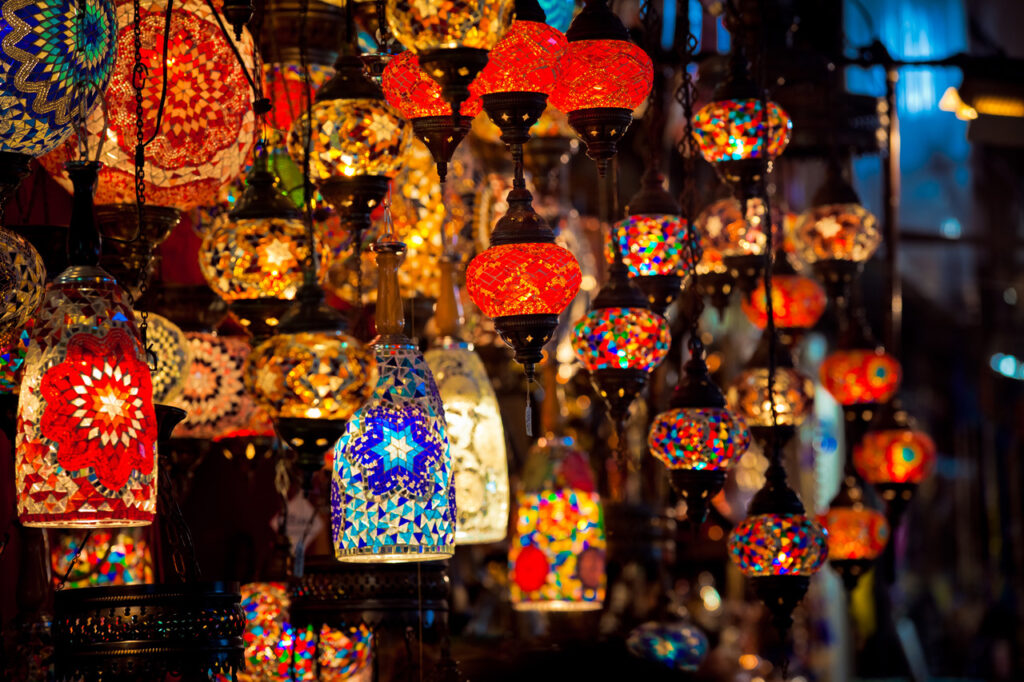
 |
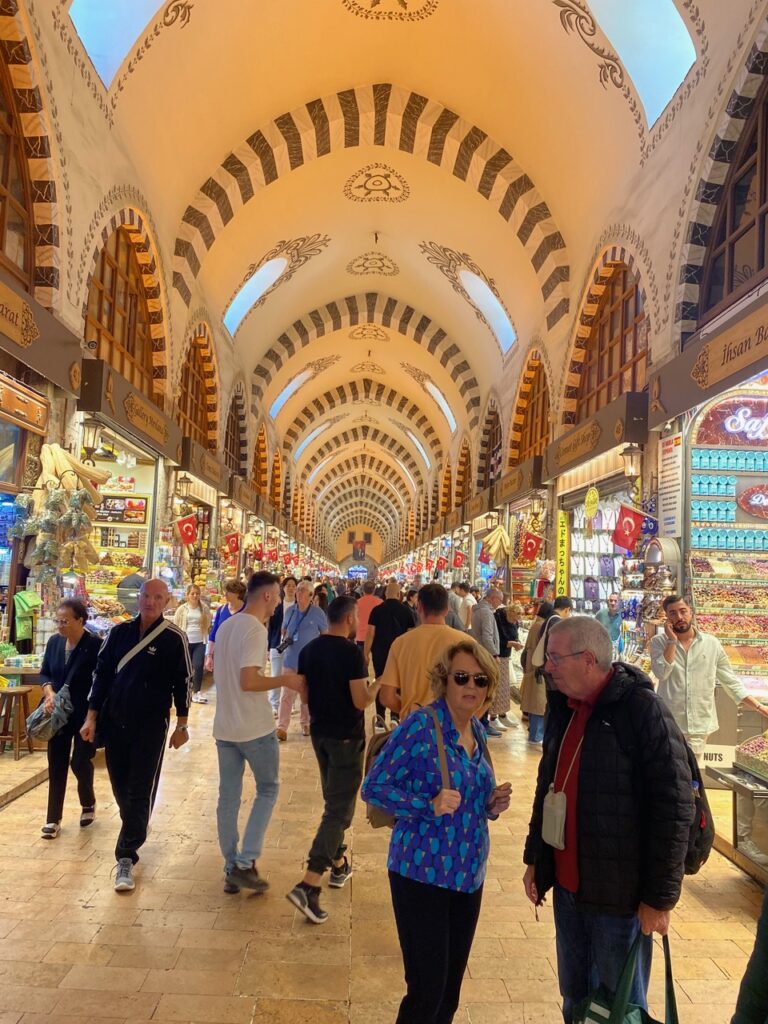 |
 |
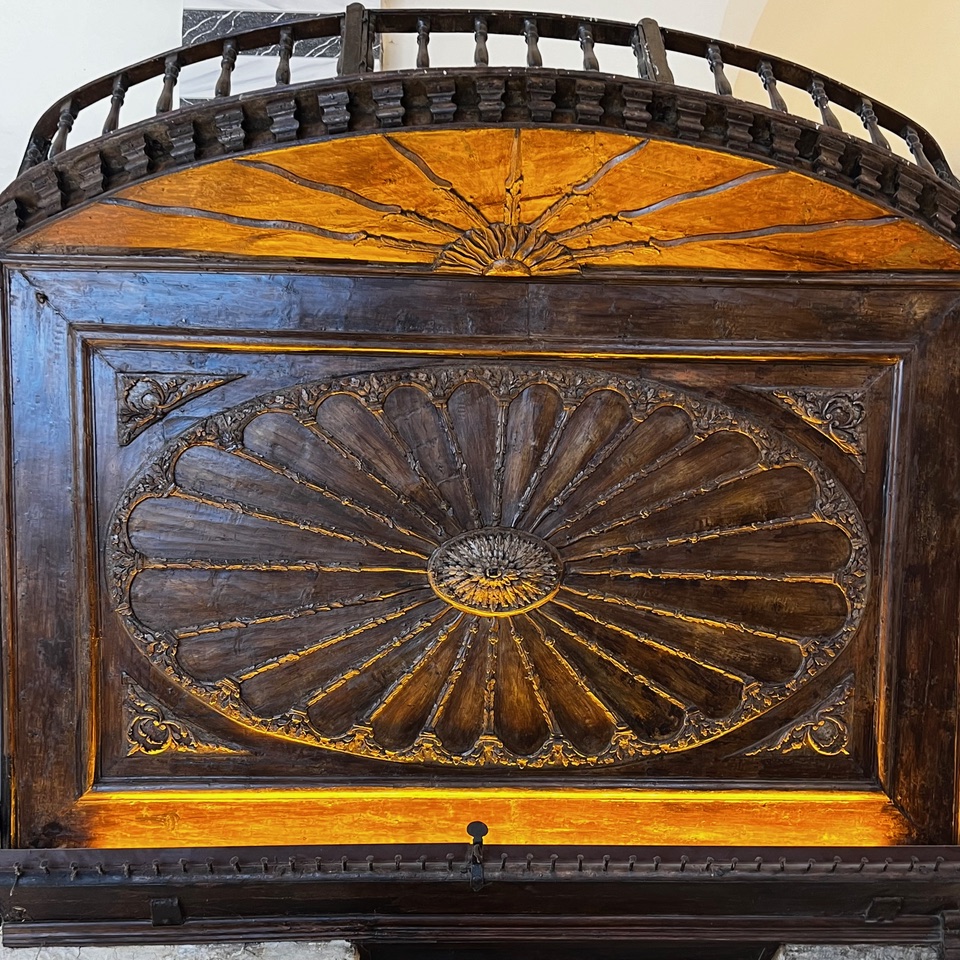
 |
 |
Turkish delight
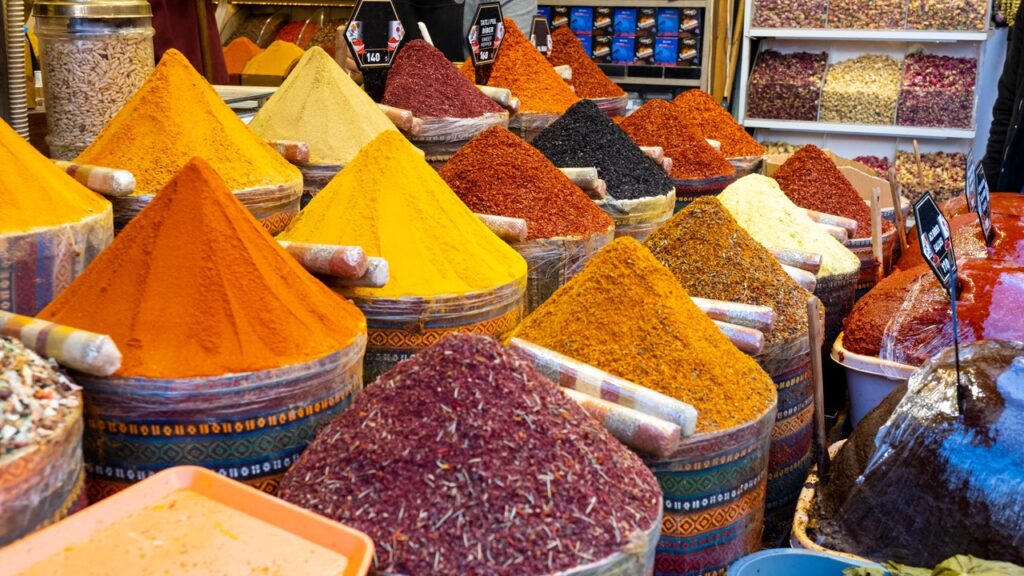
Too bad one can’t capture the divine smells in the spice market
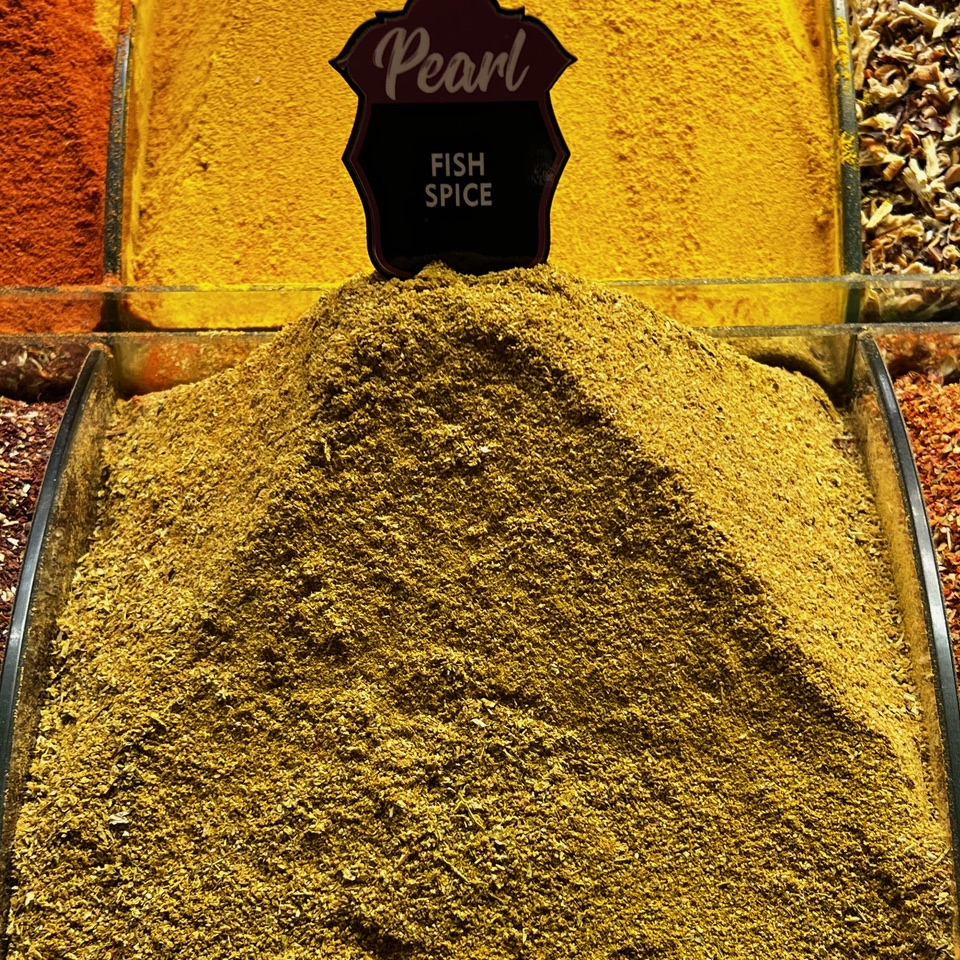 |
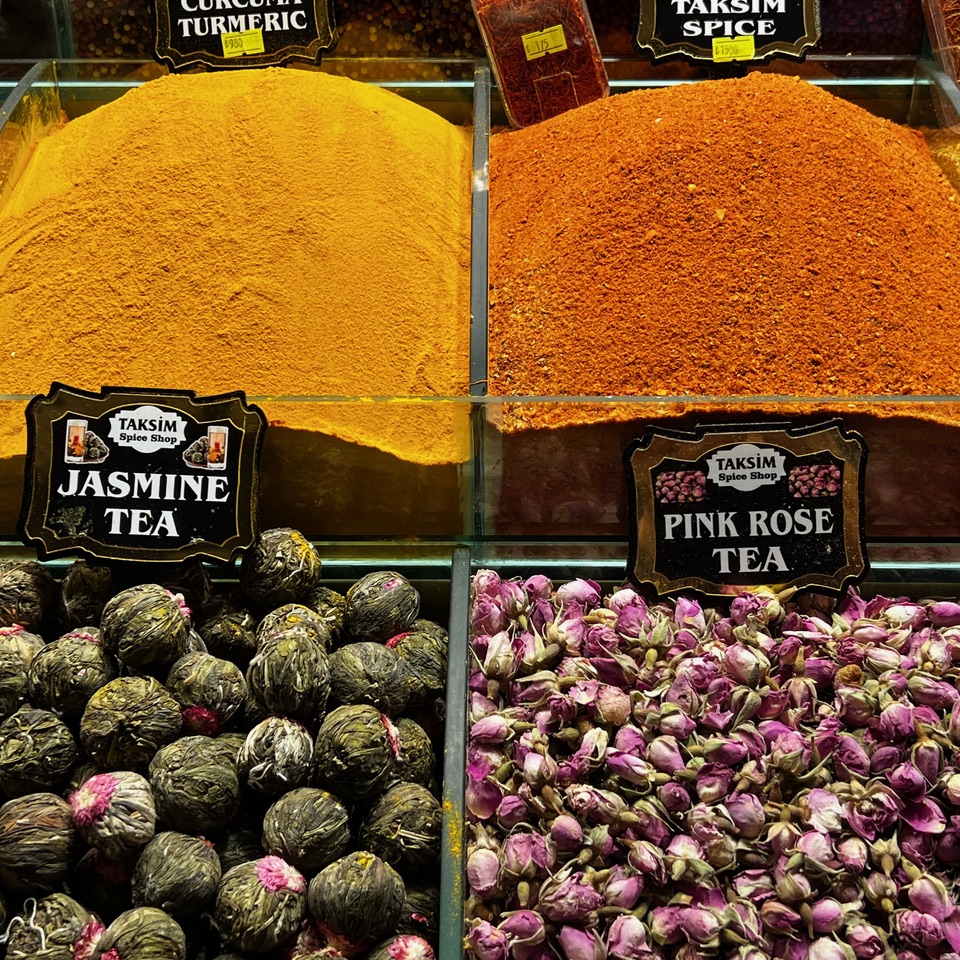 |
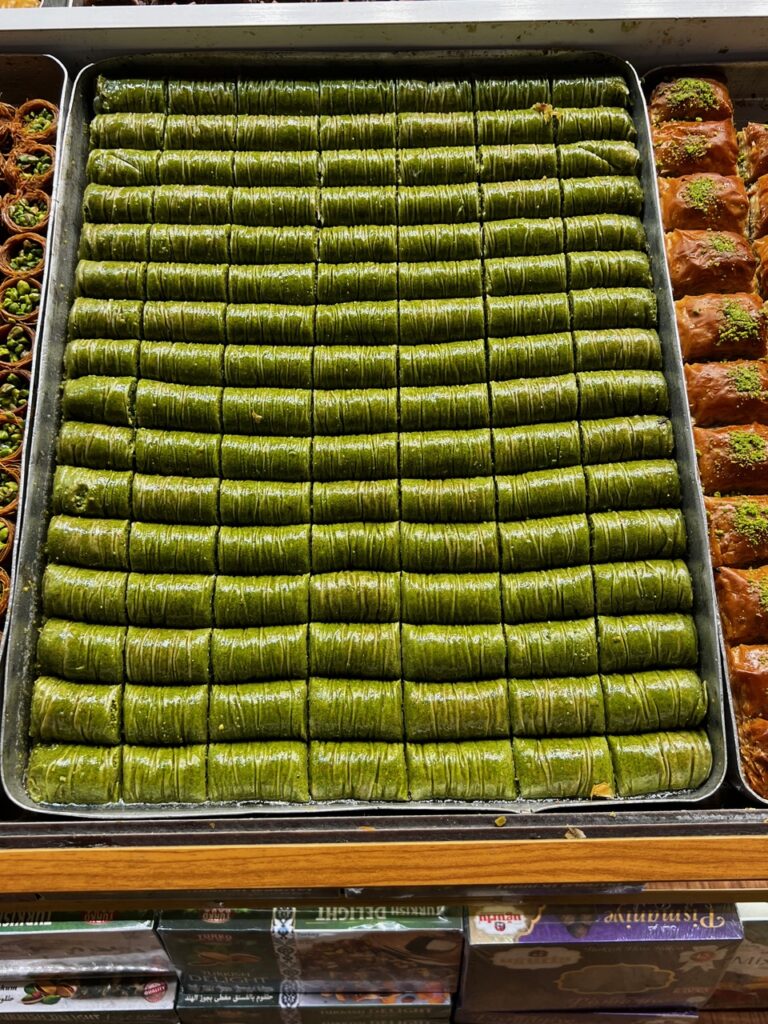 |
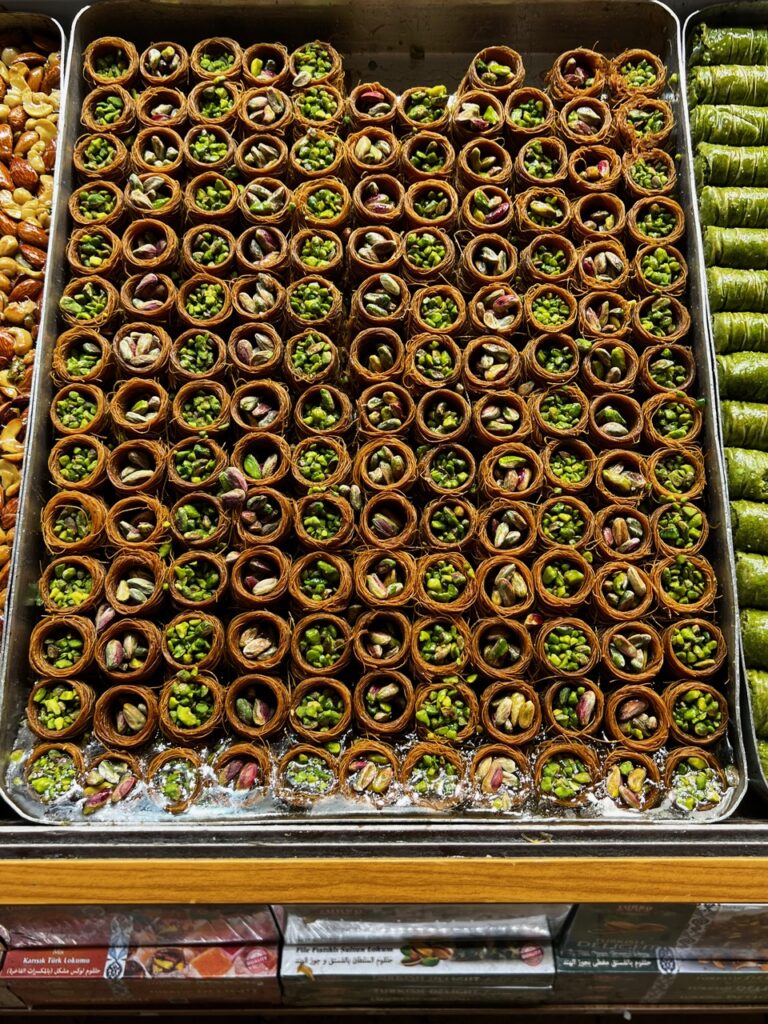 |
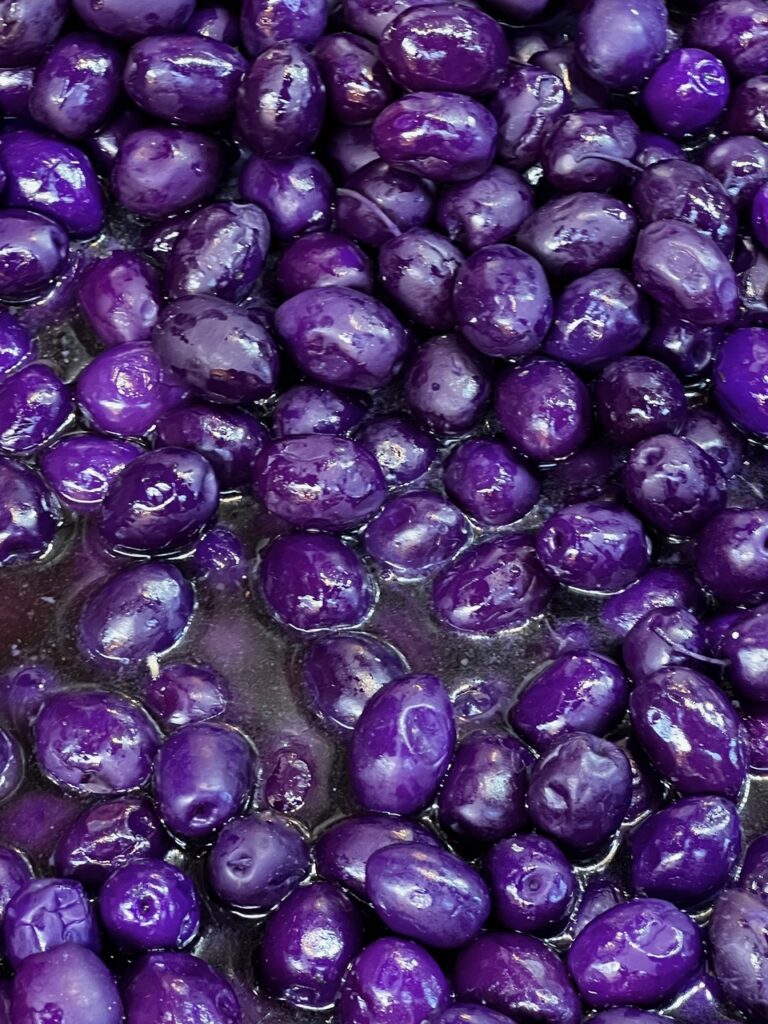 |
 |
More colors of Instanbul
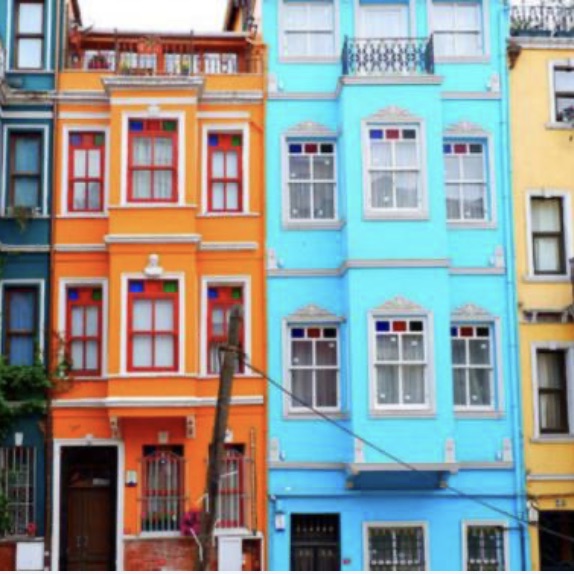 |
 |
 |
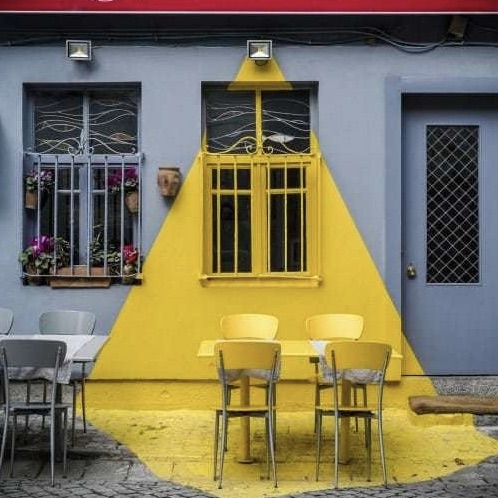 |
The Pera Palace Hotel, was completed 1895 for purpose of housing passengers of the Orient Express. Agatha Christie is thought to have written Murder on the Orient Express while staying in the hotel, this glimmering art nouveau beauty recently restored. The hotel has collected thousands of tales in its rooms, hosting famous guests:- Queen Elizabeth, Mustafa Ataturk, (founding father of the Republic of Turkey in 1934), Ernest Hemingway and Alfred Hitchcock.

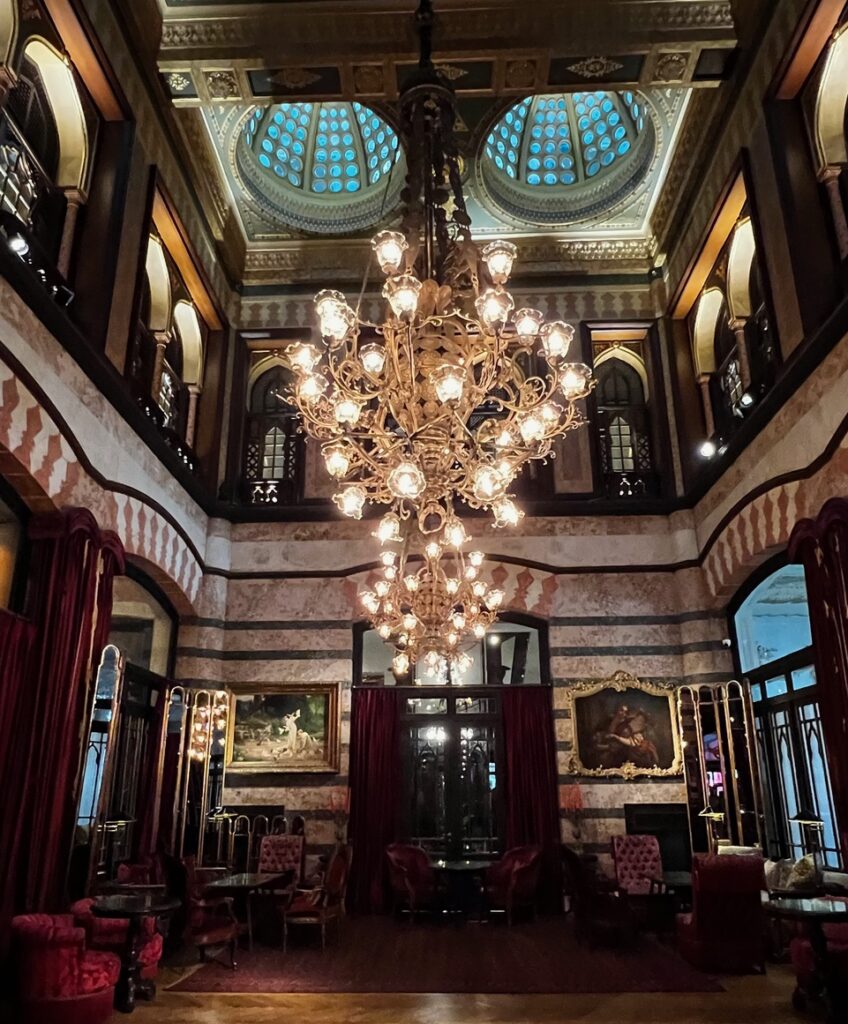 |
 |
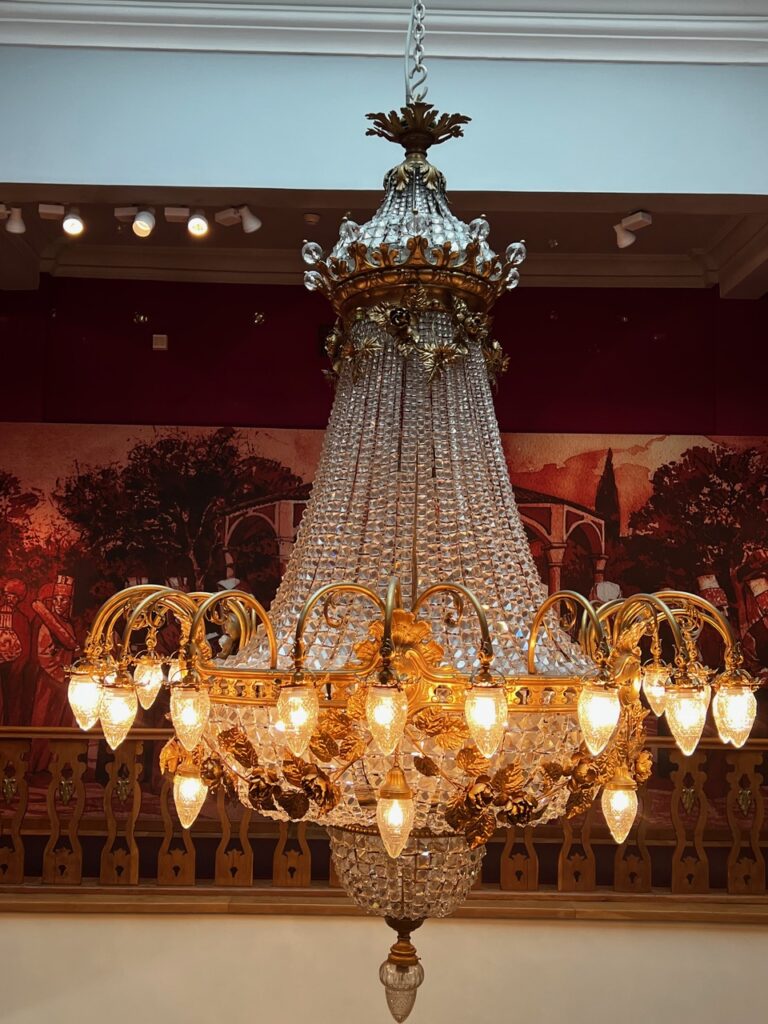 |
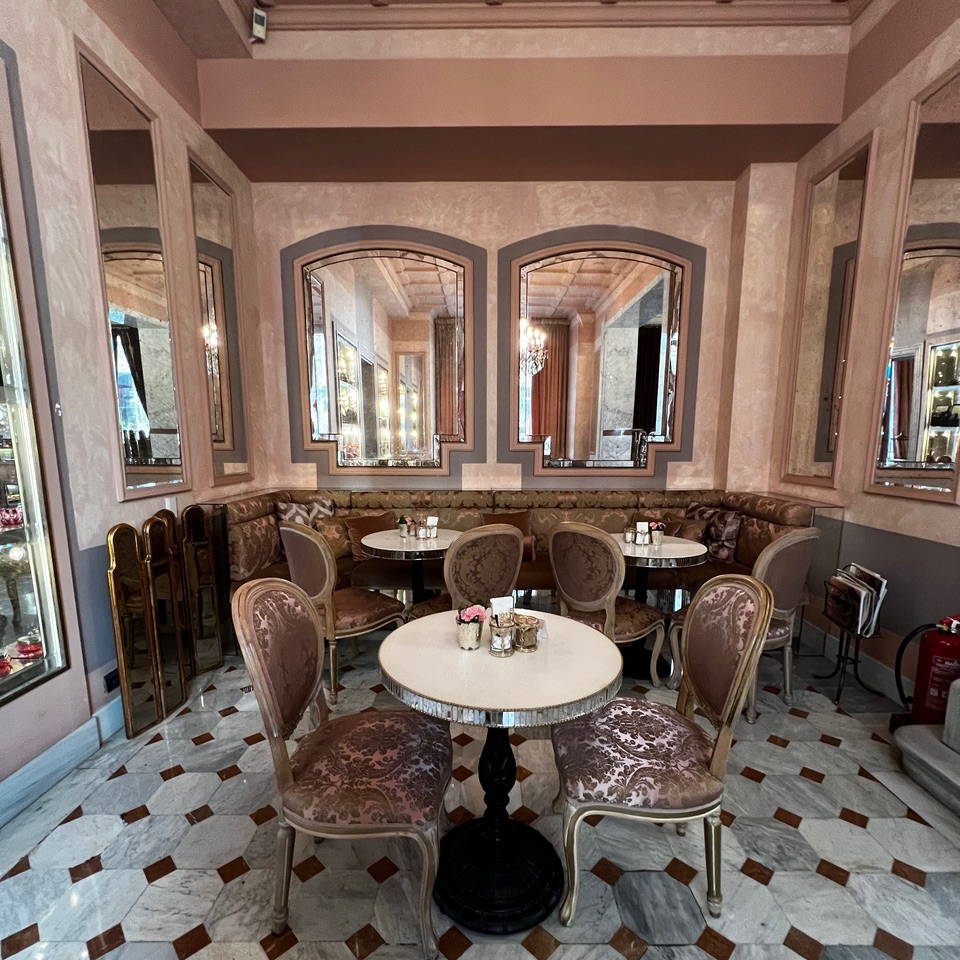 The tea room for gateaux and tea
The tea room for gateaux and tea
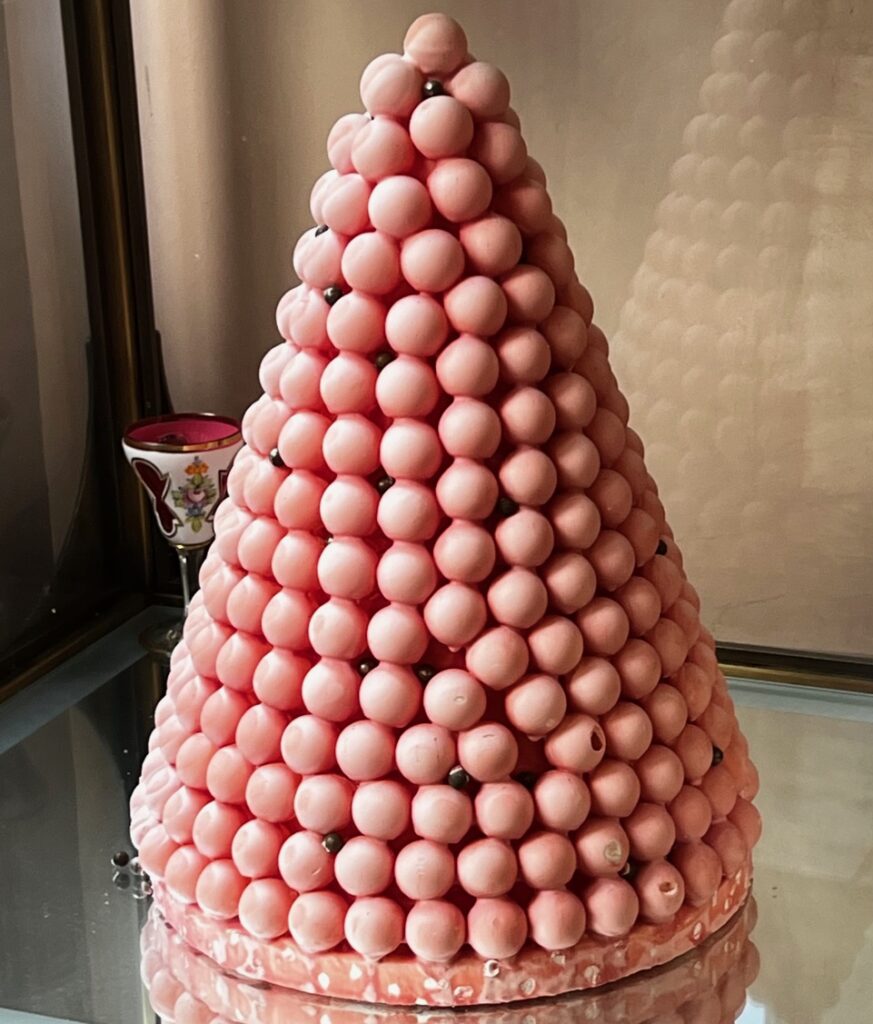
The Sakip Sabanci Museum is an absolute gem to visit. This former private collection made up of calligraphy, painting, furniture and decorative arts, contains magnificent examples of Islamic and Ottoman arts and documents dating back to 14th century.
The former family mansion is in the Emirgan area, one of the oldest settlements in Istanbul. Now it houses the museum, and is set in the lush sculpture gardens overlooking the Bosphorus, and is a delight to visit.

 |
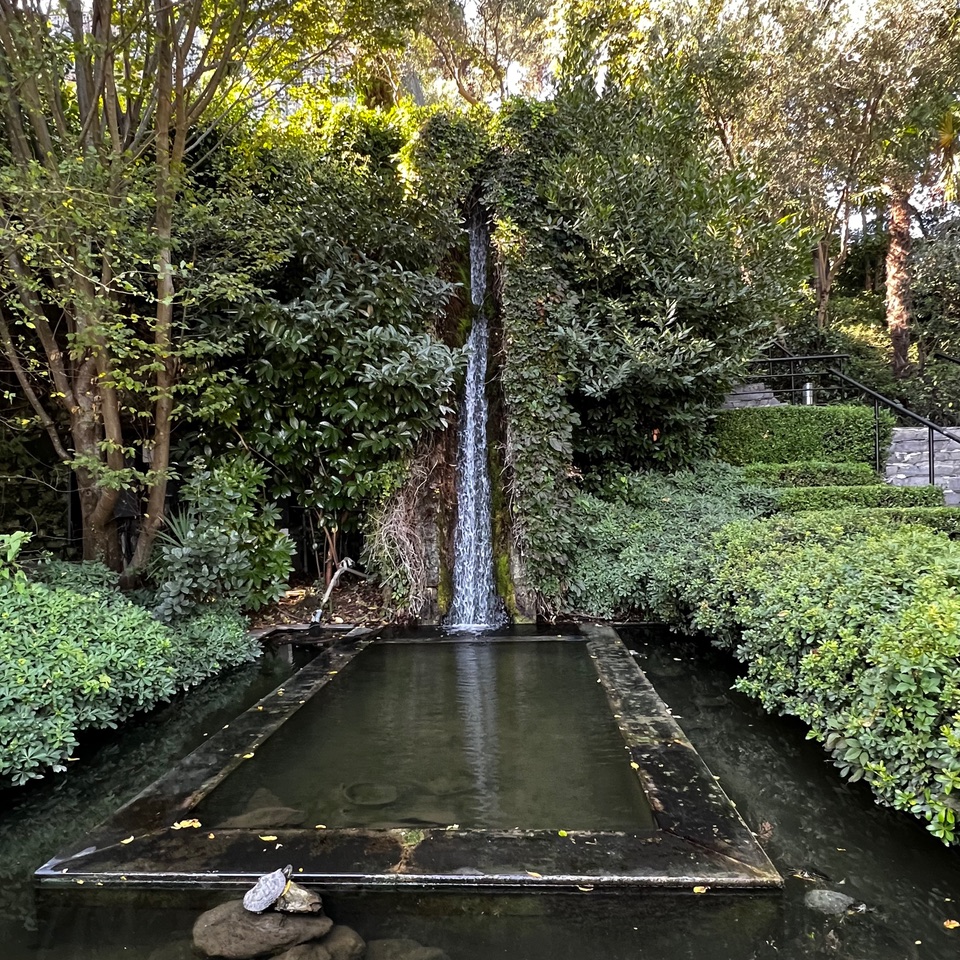 |
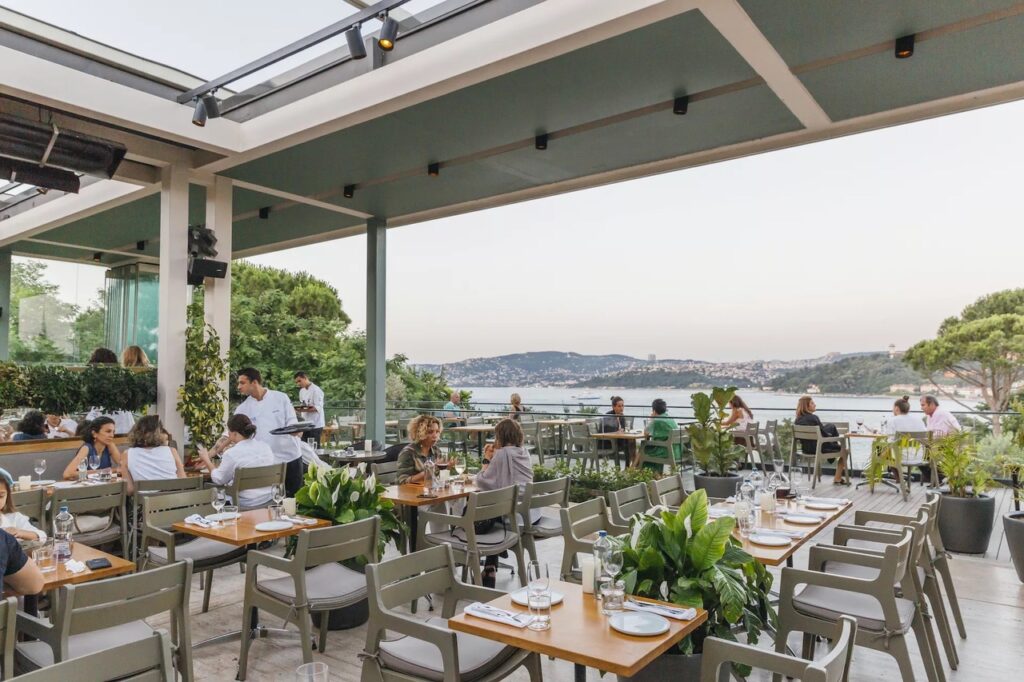
Since 2004, MSA’s Restaurant has been the culinary haven of The Culinary Arts Academy of Istanbul, Turkey’s leading culinary school. Do yourself a favor and get a reservation while visiting this exquisite museum.
Wandering the streets in Instanbul
These colorful Rainbow Steps in Cihangir neighborhood were painted by a local artist to put a smile on people’s faces. And yes they do that!
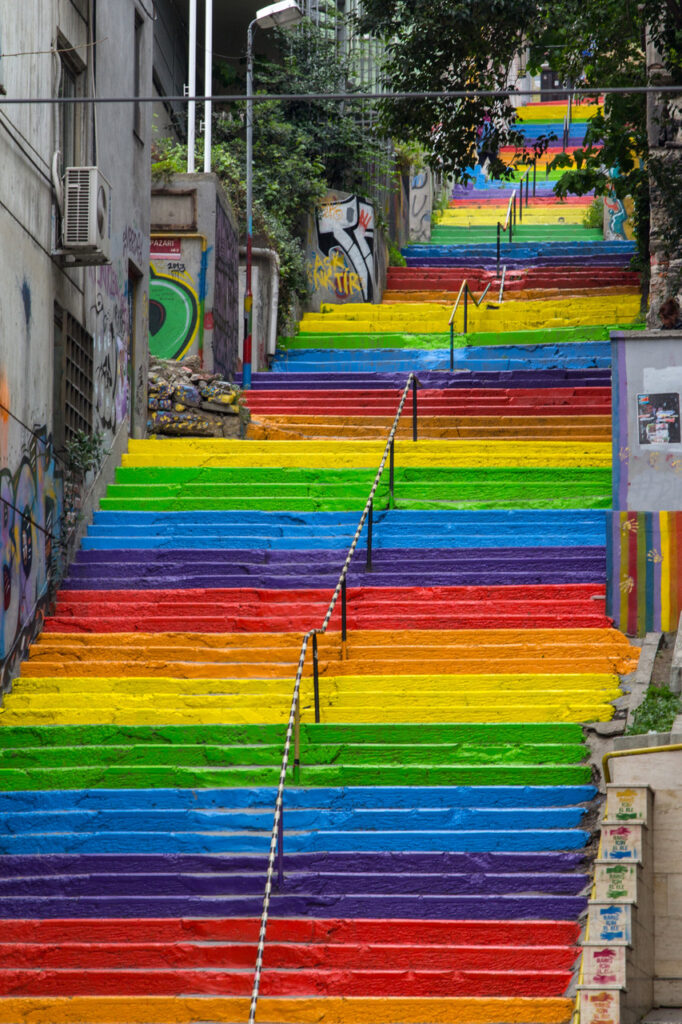
The Kamondo Steps, built around 1870, form a charming pedestrian stairway leading to Galata Tower, located on Banks Street in the Galata (Karakoy) district of Istanbul.

The lasting impression of the astonishing city of Istanbul (with or without a çeșm-i-bülbül) always includes the Bosphorus, and the minarets.
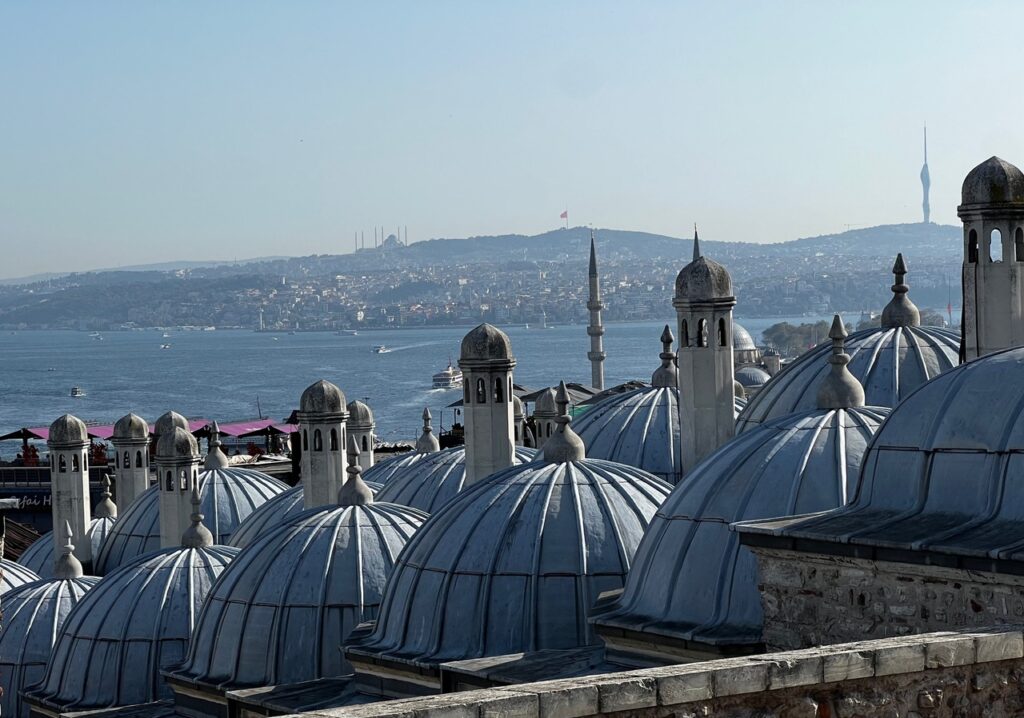
Notes, Links, further reading
Photo of Jill : Joe Mazza Bravelux inc.
Photos copyright © 2024 Jill Lowe. All rights reserved
Images with Shutterstock license
Very many books set in or about Istanbul can be found but for me 2 authors emerge as illuminative and passionate about the city:-
*Stephen Kinzer CRESCENT AND STAR: Turkey Between Two Worlds
*Orhan Pamuk Istanbul Memories and the City
and My Name is Red.
Sakip Sabanci Museum In Emirgan



